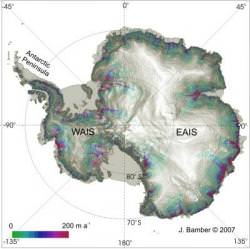Increasing amounts of ice mass have been lost from West Antarctica and the Antarctic peninsula over the past ten years, according to a 10-year study from the University of Bristol, England. But at the same time, however, the ice mass in East Antarctica has been roughly stable, with neither loss nor accumulation over the past decade.
Professor Jonathan Bamber at the University of Bristol and colleagues estimated a loss of 132 billion tons of ice in 2006 from West Antarctica “up from about 83 billion tons in 1996” and a loss of about 60 billion tons in 2006 from the Antarctic Peninsula.
“To put these figures into perspective,” Bamber said, “four billion tons of ice is enough to provide drinking water for the whole of the UK population for one year.”
The data comes from satellite imagery that cover 85% of Antarctica’s coastline, which the researchers compared with simulations of snow accumulation over the same period, using a regional climate model.
“Over the 10 year time period of the survey, the ice sheet as a whole was certainly losing mass,” said Bamber, “and the mass loss increased by 75% during this time. Most of the mass loss is from the Amundsen Sea sector of West Antarctica and the northern tip of the Peninsula where it is driven by ongoing, pronounced glacier acceleration.”
In East Antarctica, the mass balance, which accounts for addition to the ice sheet due to snowfall and the subtraction of ice due to changes in the glacier, is near zero. But the thinning of its potentially vulnerable marine sectors suggests this may change in the near future.
As to the differences in the West and East Antarctic ice sheets, Bamber said, “The West Antarctic Ice Sheet is a “marine based” ice sheet resting on bedrock below sea level with bed slopes inclined downward inland. It has been suggested that this makes the WAIS more susceptible to change caused by the ocean than the East Antarctic Ice Sheet.”
The study conclude that the Antarctic ice sheet mass budget is more complex than indicated by the evolution of its surface mass balance or climate-driven predictions.
Changes in glacier dynamics are significant and may in fact dominate the ice sheet mass budget. This conclusion is contrary to model simulations of the response of the ice sheet to future climate change, which conclude that it will grow due to increased snowfall.
Satellite data was obtained from ERS-1, ERS-2, RADARSAT and ALOS.
Original News Source: University of Bristol Press Release

